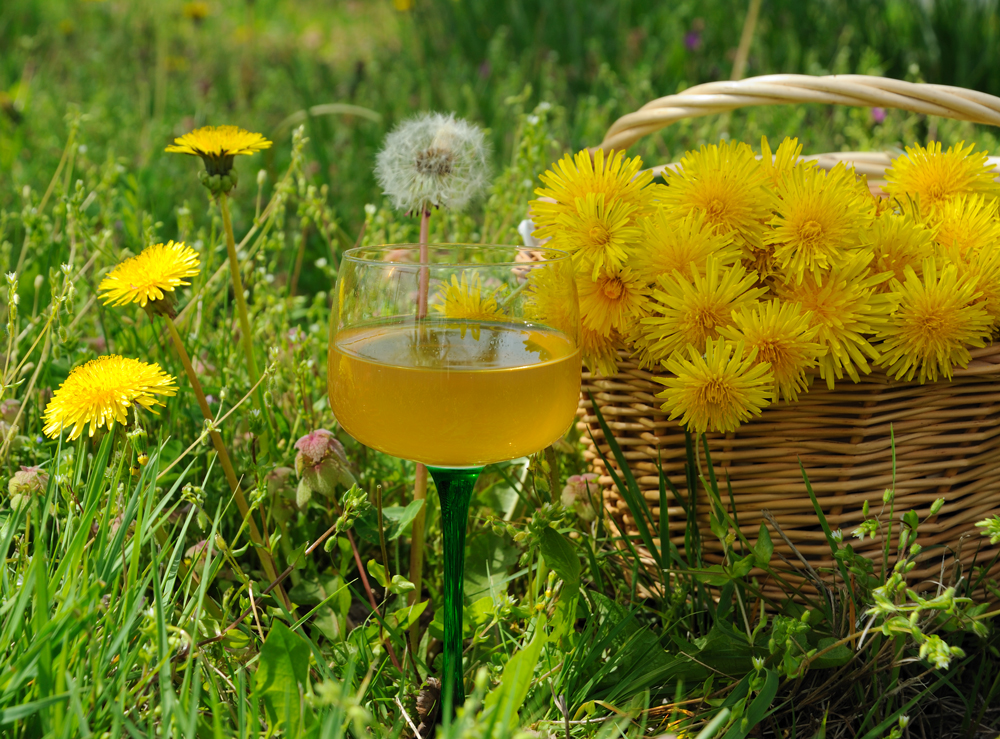
“Dandelion wine.
The words were summer on the tongue. The wine was summer caught and stoppered….
Hold summer in your hand, pour summer in a glass, a tiny glass of course, the smallest tingling sip for children; change the season in your veins by raising glass to lip and tilting summer in.”
Ray Bradbury
“Dandelion Wine” by Ray Bradbury is a poetic tribute to summers and happy childhoods. To me, the wine in this book has always been a metaphor for beautiful memories, especially given the unique process described. However, several years ago, I discovered that dandelion wine is a real and longstanding tradition in American home winemaking.
“So, plucked carefully, in sacks, the dandelions were carried below. The cellar dark glowed with their arrival. The wine press stood open, cold. A rush of flowers warmed it. The press, replaced, its screw rotated, twirled by Grandfather, squeezed gently on the crop.
“There … so …”
The golden tide, the essence of this fine fair month ran, then gushed from the spout below, to be crocked, skimmed of ferment, and bottled in clean ketchup shakers, then ranked in sparkling rows in cellar gloom.”
Although the recipe in the book does not reflect the reality of making dandelion wine, as the juice is too bitter and lacks sufficient sugar for fermentation, I believe that Bradbury wrote his recipe based on common knowledge of grape winemaking, without considering dandelion properties and technology.
Technically, dandelion wine is not a wine, but a type of mead.
It was brought to America by European immigrants from relatively northern countries where grapes did not grow, and imported wine was only affordable for the wealthy. In these regions, dandelion wine was produced from honey, as it provided the necessary sugar for fermentation, which was cheaper and more accessible than pure sugar at those days.
In America, after the advent of affordable and pure sugar, housewives quickly switched to using it, leading to most American dandelion wine recipes being based on sugar.
The recipe for dandelion wine generally consists of honey (or sugar), dandelion petals (which provide the drink with a bitter-sweet floral aroma), and citruses (which add necessary acidity). Though primarily a homemade wine, some commercial wineries, including Amish ones, also produce dandelion wine.
Traditionally this wine is made sweet, but it can be made dry, of course.
Although I am a theoretical viniculture expert and do not own a winery, I decided to make dandelion wine myself last April. I collected various recipes and compiled my own based on my knowledge, and as a fan of dry wine, I made it dry. Now, it’s time to taste and enjoy the fruits of my labor.
I made two variants – one with honey and one with sugar. Predictably, the mead with honey has a more complex and interesting taste.
Many suggest the possibility to use baking yeast instead of wine. Don’t recommend it. Of course, they will work, but will not improve the taste.
Recipe
Ingredients:
-300 grams of dandelion petals (it is about 500 grams of flowers, that is about 5 litres)
-3 litres of water
-450 grams of honey (or sugar)
-zest and juice from 2 big oranges (or 3 medium)
– zest and juice from 2 big lemons (or 3 medium)
-a handful of raisins (about 30 grams), chopped
-1 (5 grams) packet of wine yeast (I used champagne)
Process:
On a sunny spring day go to a lawn covered with dandelions (better check that this is not a regular doggy place), and quickly collect flowers. Then go home and quickly separate petals from green parts. We have only a couple of hours (3 at max) before the flowers close. After this, the separation would be much more difficult. Green parts give strong bitterness, so it is not a good idea to use whole flowerheads, although some passed green pieces are ok.
Put petals in a non-reactive vessel (glass, ceramic, stainless still). Bring water to a boil and pour over the petals. Let the mixture sit overnight.
Transfer the liquid into a big pan through cheesecloth or butter muslin. Extract as much liquid as possible, Discard petals.
Bring dandelion infusion to the boil. Add honey or sugar and dissolve. Add zest, juice, and raisins. Remove from heat and set aside to cool.
When the mixture has cooled to room temperature, stir in yeast.
Strain into a sanitized jug and seal with either a fermentation lock or balloon with a single pinprick in it. I used balloons. Leave at room temperature until the end of fermentation. It takes about three weeks.
Carefully pour the liquid into another sanitized jug with a swing-stopper, leaving behind yeast sediment. Set in a cool dark place for 2-3 months. It is time for residual fermentation and sedimentation.
Carefully transfer the wine to sanitized bottles, leaving behind sediment. Cork bottle (or use crew cap) and sent in back in a cool dark place.
Dandelion wine requires one-two years of ageing. Keeping it longer doesn’t make sense, after two years it starts to lose taste.
My mead is a golden dry drink with a bright dandelion aroma and nice bitter-floral taste. Unusual and interesting.
Dandelion wine is a variant to bring some diversity in your alcohol menu, especially good to thematic treatment.
Visit my online store for a unique poster featuring this drink, along with many other beautiful cocktails and other wine-related subjects.
It’s the perfect way to add a touch of sophistication to your kitchen or bar. Click here to shop now!